fuel type TOYOTA YARIS SEDAN 2010 Owners Manual
[x] Cancel search | Manufacturer: TOYOTA, Model Year: 2010, Model line: YARIS SEDAN, Model: TOYOTA YARIS SEDAN 2010Pages: 386, PDF Size: 6.95 MB
Page 6 of 386
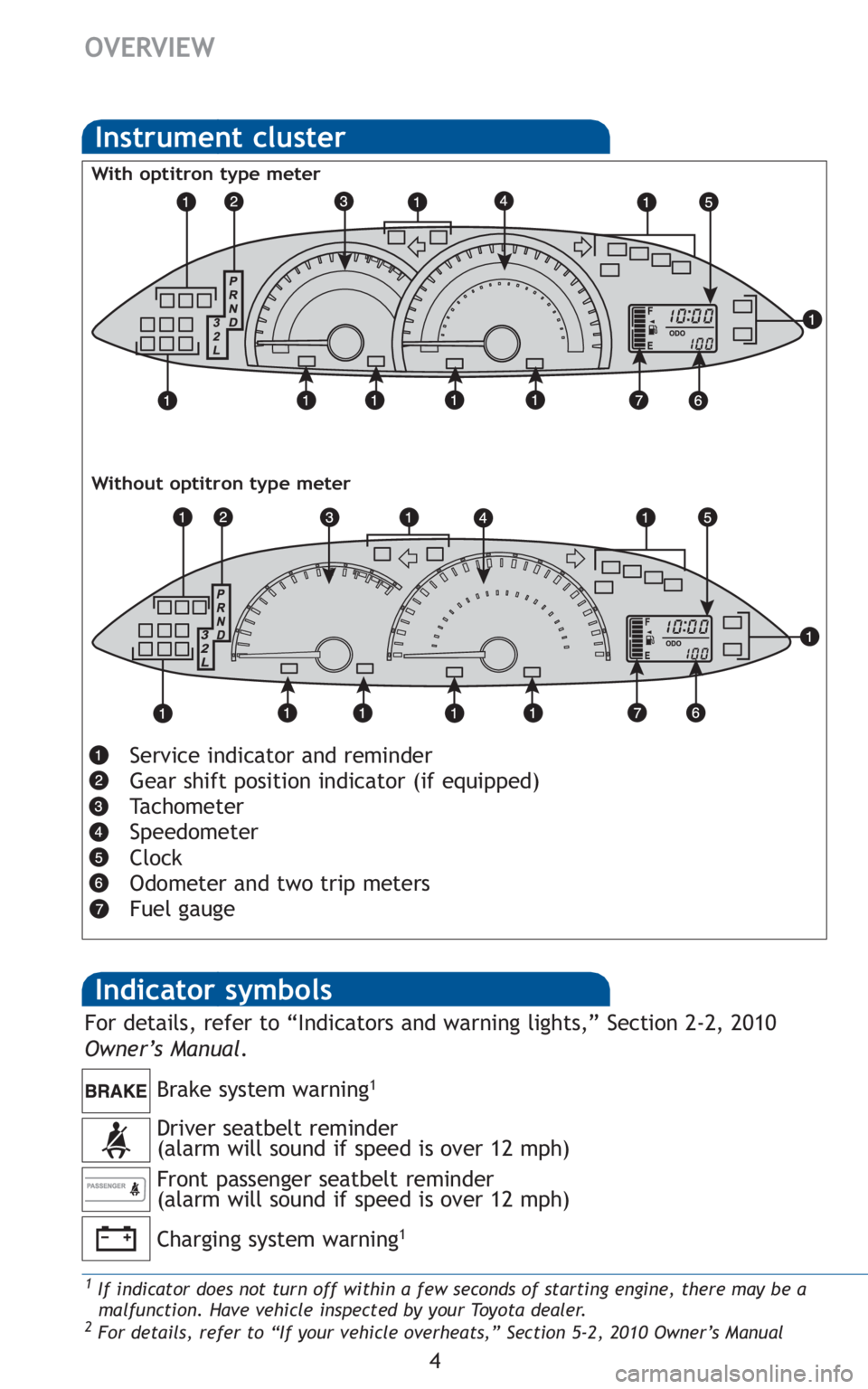
4
OVERVIEW
Driver seatbelt reminder
(alarm will sound if speed is over 12 mph)
Front passenger seatbelt reminder
(alarm will sound if speed is over 12 mph)
Brake system warning
1
Charging system warning1
1If indicator does not turn off within a few seconds of starting engine, there may be a
malfunction. Have vehicle inspected by your Toyota dealer.
2For details, refer to “If your vehicle overheats,” Section 5-2, 2010 Owner’s Manual
Indicator symbols
Service indicator and reminder
Gear shift position indicator (if equipped)
Tachometer
Speedometer
Clock
Odometer and two trip meters
Fuel gauge
Instrument cluster
With optitron type meter
Without optitron type meter
For details, refer to “Indicators and warning lights,” Section 2-2, 2010
Owner’s Manual .
Page 73 of 386
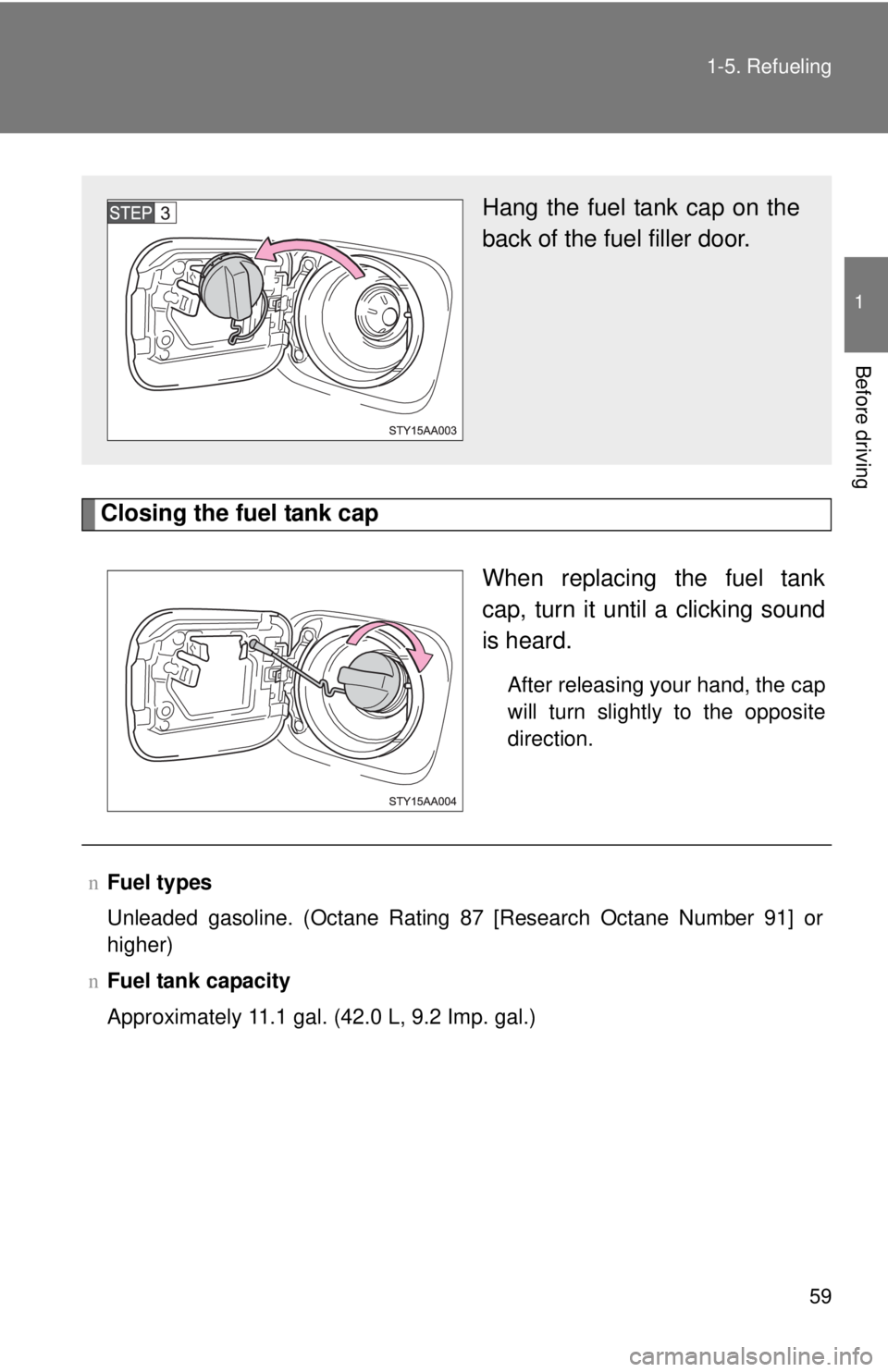
59
1-5. Refueling
1
Before driving
Closing the fuel tank cap
When replacing the fuel tank
cap, turn it until a clicking sound
is heard.
After releasing your hand, the cap
will turn slightly to the opposite
direction.
Hang the fuel tank cap on the
back of the fuel filler door.
nFuel types
Unleaded gasoline. (Octane Rating 87 [Research Octane Number 91] or
higher)
n Fuel tank capacity
Approximately 11.1 gal. (42.0 L, 9.2 Imp. gal.)
Page 134 of 386
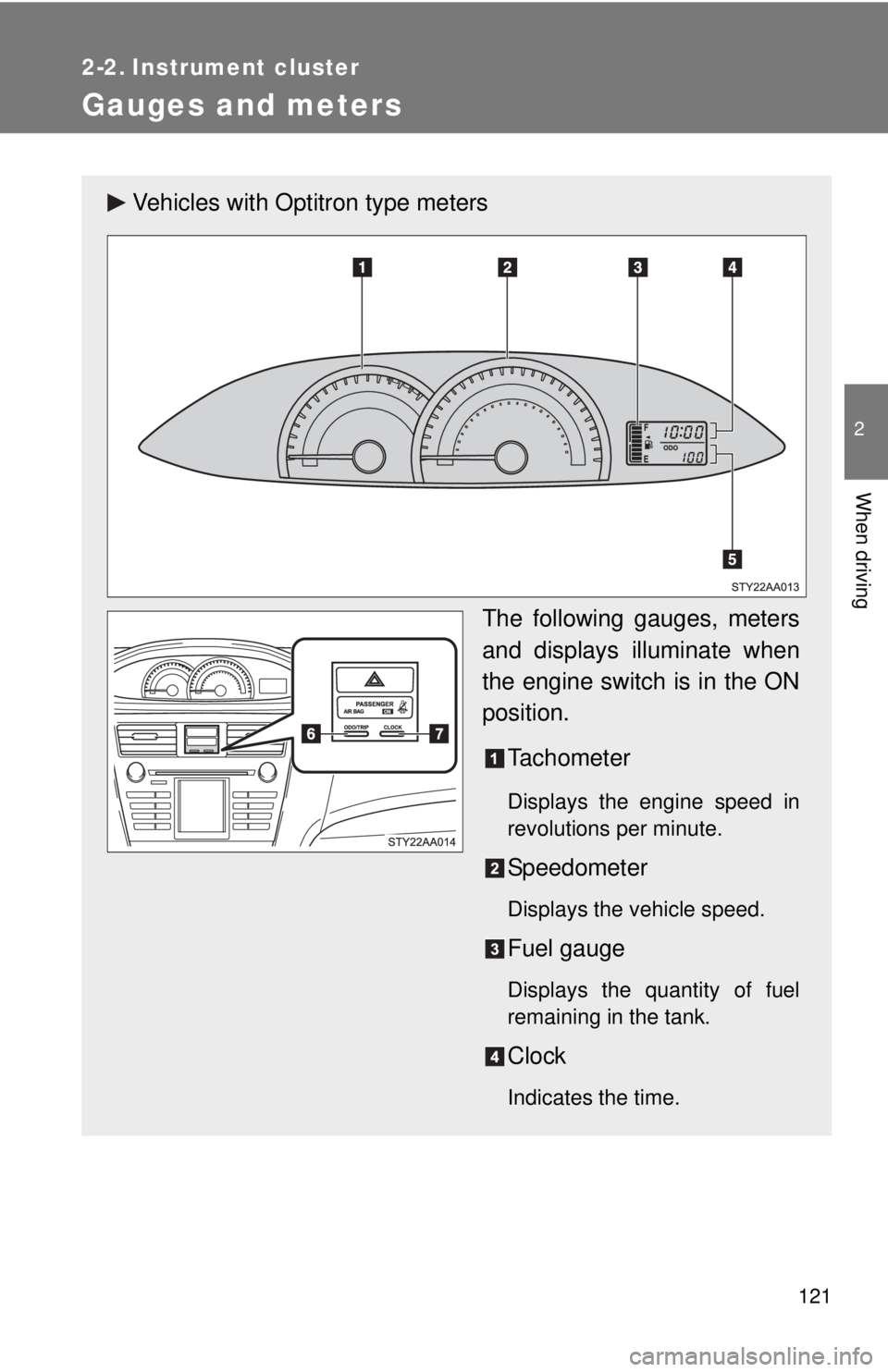
121
2
When driving
2-2. Instrument cluster
Gauges and meters
Vehicles with Optitron type metersThe following gauges, meters
and displays illuminate when
the engine switch is in the ON
position.Tachometer
Displays the engine speed in
revolutions per minute.
Speedometer
Displays the vehicle speed.
Fuel gauge
Displays the quantity of fuel
remaining in the tank.
Clock
Indicates the time.
Page 136 of 386
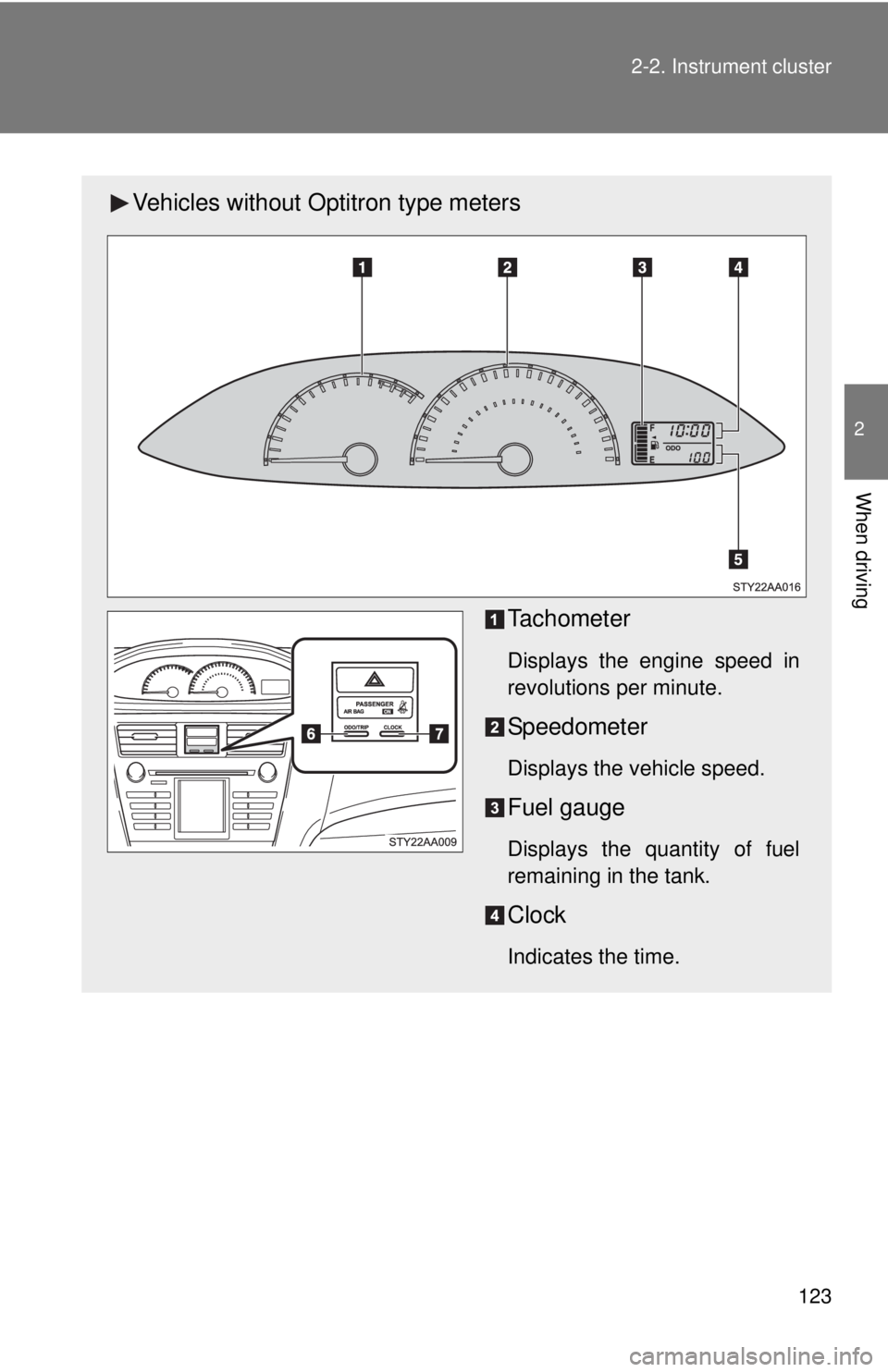
123
2-2. Instrument cluster
2
When driving
Vehicles without Optitron type meters
Tachometer
Displays the engine speed in
revolutions per minute.
Speedometer
Displays the vehicle speed.
Fuel gauge
Displays the quantity of fuel
remaining in the tank.
Clock
Indicates the time.
Page 279 of 386
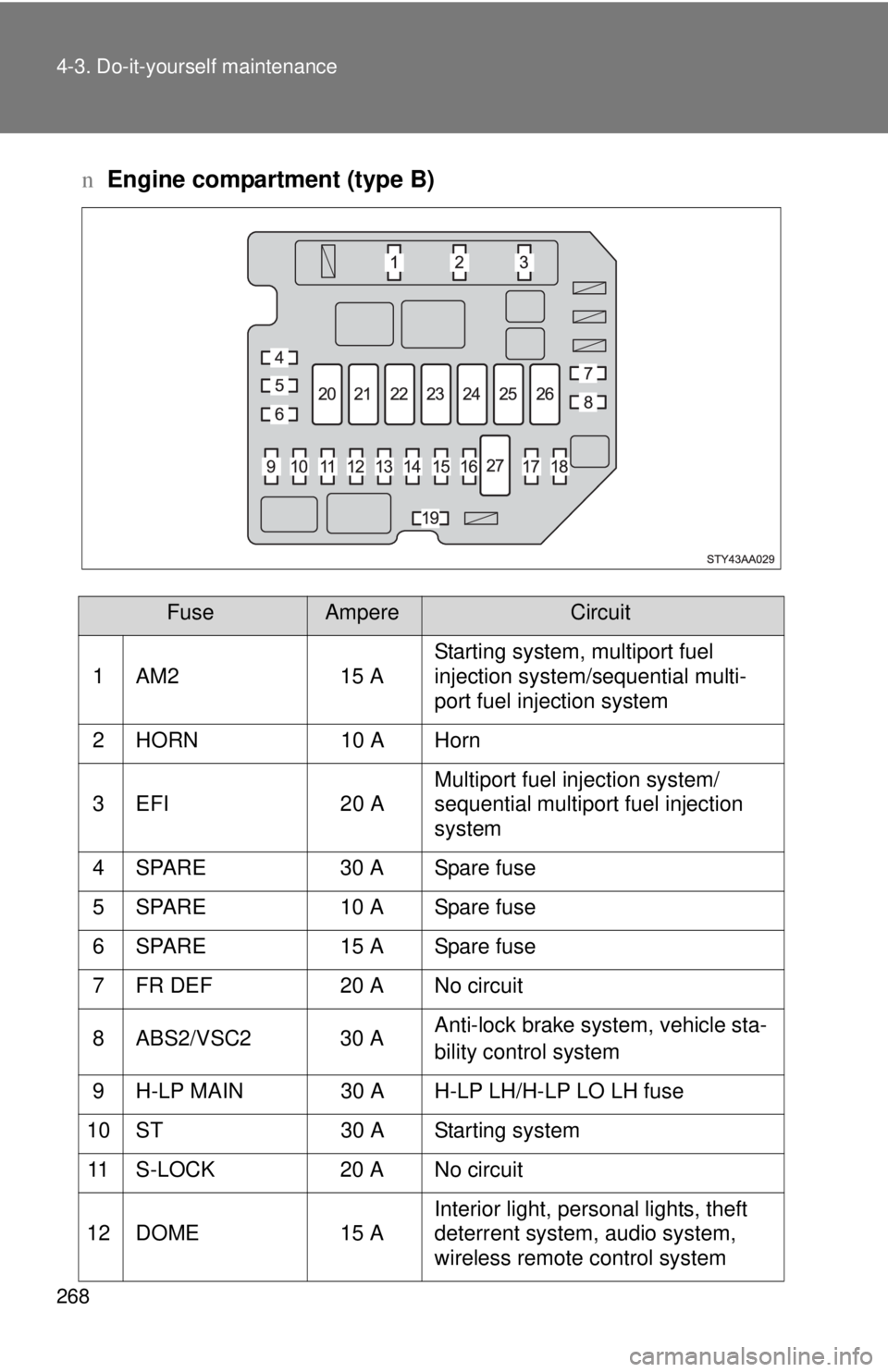
268 4-3. Do-it-yourself maintenance
nEngine compartment (type B)
FuseAmpereCircuit
1 AM2 15 A Starting system, multiport fuel
injection system/sequential multi-
port fuel injection system
2 HORN 10 A Horn
3 EFI 20 A Multiport fuel injection system/
sequential multiport fuel injection
system
4 SPARE 30 A Spare fuse
5 SPARE 10 A Spare fuse
6 SPARE 15 A Spare fuse
7 FR DEF 20 A No circuit
8 ABS2/VSC2 30 A Anti-lock brake system, vehicle sta-
bility control system
9 H-LP MAIN 30 A H-LP LH/H-LP LO LH fuse
10 ST 30 A Starting system 11 S-LOCK 20 A No circuit
12 DOME 15 A Interior light, personal lights, theft
deterrent system, audio system,
wireless remote control system
Page 282 of 386
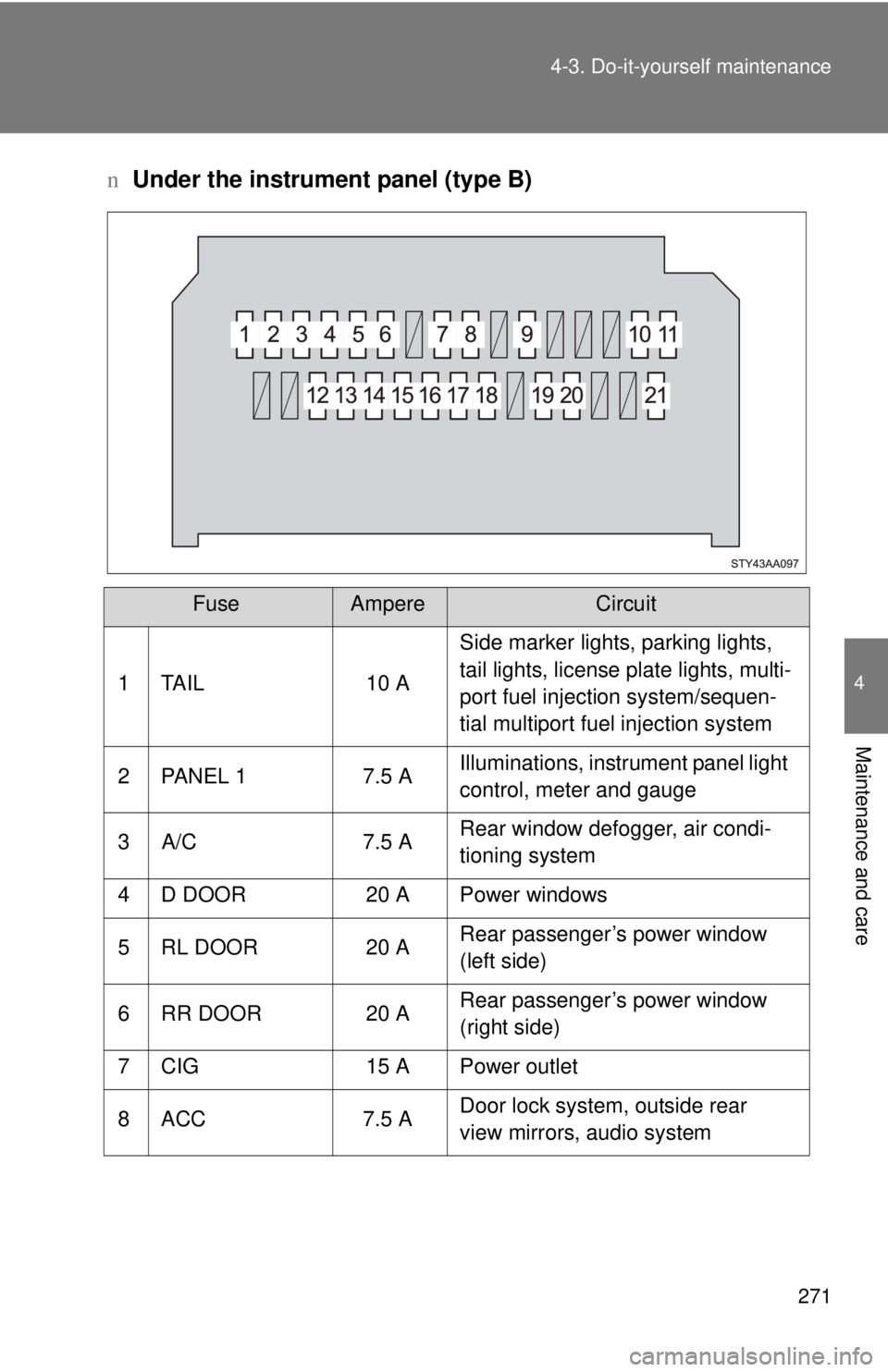
271
4-3. Do-it-yourself maintenance
4
Maintenance and care
n
Under the instrument panel (type B)
FuseAmpereCircuit
1 TAIL 10 A Side marker lights, parking lights,
tail lights, license plate lights, multi-
port fuel injection system/sequen-
tial multiport fuel injection system
2 PANEL 1 7.5 A Illuminations, instrument panel light
control, meter and gauge
3 A/C 7.5 A Rear window defogger, air condi-
tioning system
4 D DOOR 20 A Power windows
5 RL DOOR 20 A Rear passenger’s power window
(left side)
6 RR DOOR 20 A Rear passenger’s power window
(right side)
7 CIG 15 A Power outlet
8 ACC 7.5 A Door lock system, outside rear
view mirrors, audio system
Page 344 of 386
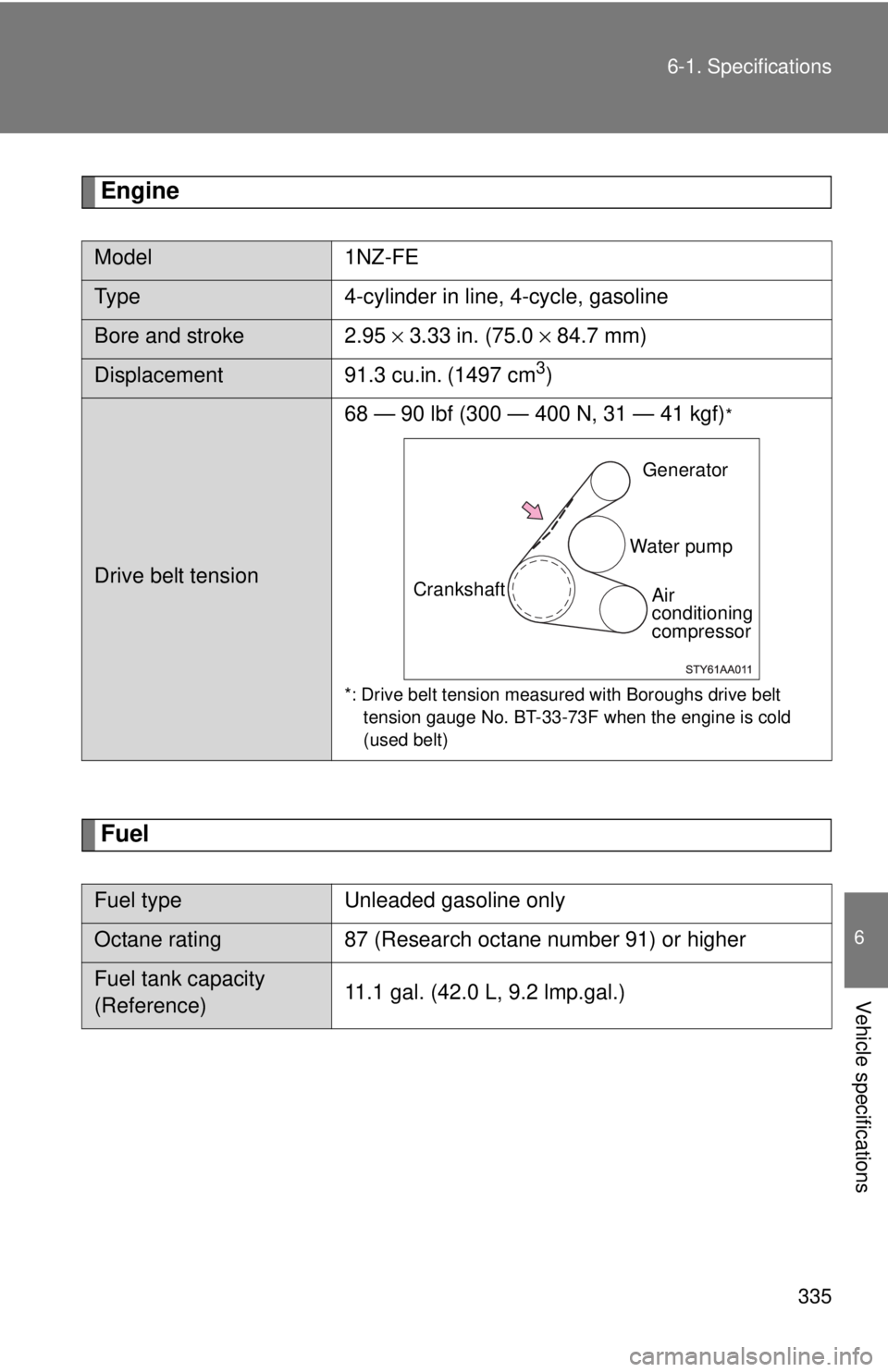
335
6-1. Specifications
6
Vehicle specifications
Engine
Fuel
Model
1NZ-FE
Type 4-cylinder in line, 4-cycle, gasoline
Bore and stroke 2.95 × 3.33 in. (75.0 × 84.7 mm)
Displacement 91.3 cu.in. (1497 cm3)
Drive belt tension 68 — 90 lbf (300 — 400 N, 31 — 41 kgf)
*
*: Drive belt tension measur ed with Boroughs drive belt
tension gauge No. BT-33-73F when the engine is cold
(used belt)
Fuel type Unleaded gasoline only
Octane rating87 (Research octane number 91) or higher
Fuel tank capacity
(Reference) 11.1 gal. (42.0 L, 9.2 lmp.gal.)
Generator
Water pump Air
conditioning
compressor
Crankshaft
Page 353 of 386
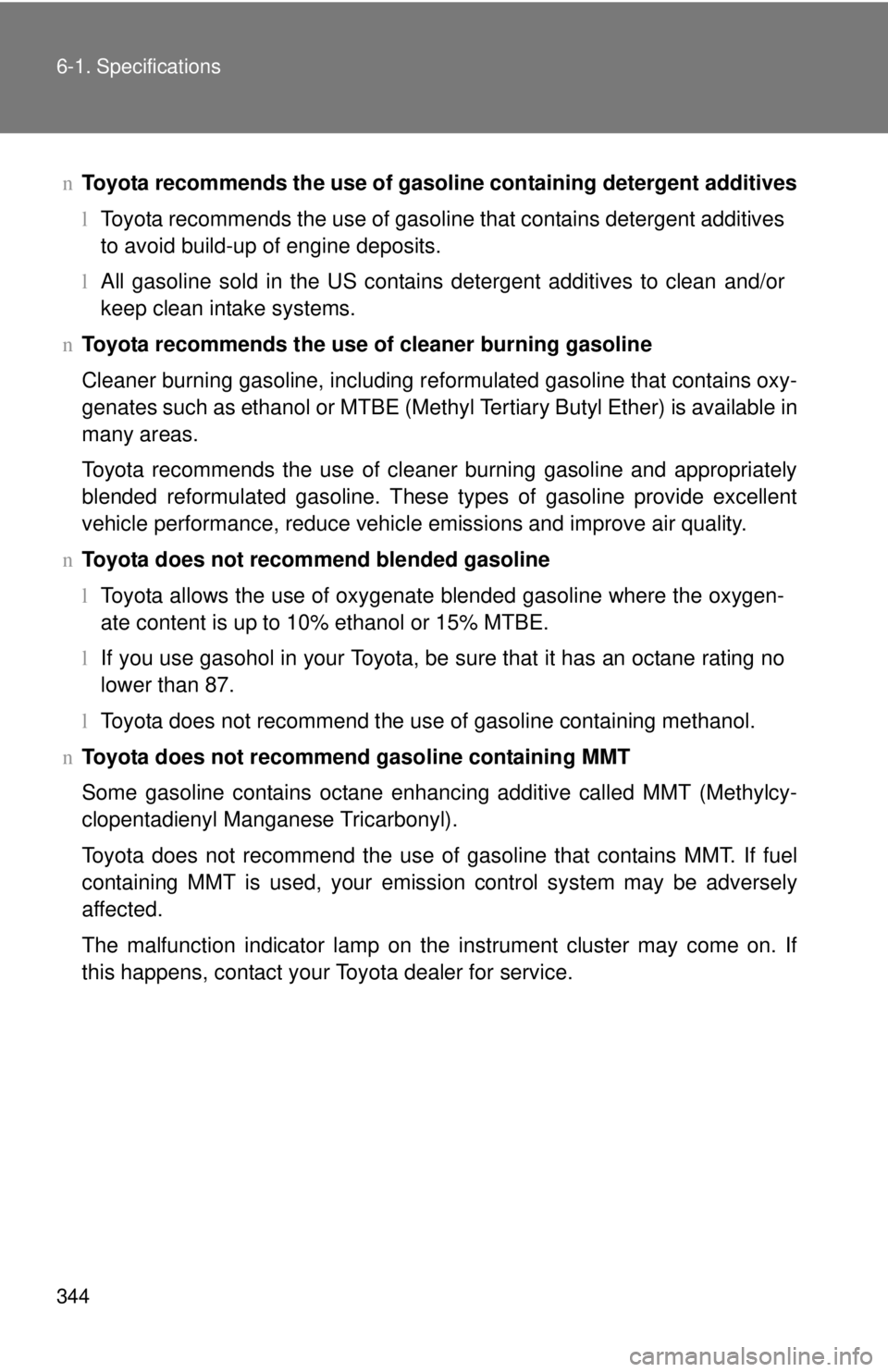
344 6-1. Specifications
nToyota recommends the use of gaso line containing detergent additives
l Toyota recommends the use of gasoline that contains detergent additives
to avoid build-up of engine deposits.
l All gasoline sold in the US contains detergent additives to clean and/or
keep clean intake systems.
n Toyota recommends the use of cleaner burning gasoline
Cleaner burning gasoline, including reformulated gasoline that contains oxy-
genates such as ethanol or MTBE (Methyl Tertiary Butyl Ether) is available in
many areas.
Toyota recommends the use of cleaner burning gasoline and appropriately
blended reformulated gasoline. These types of gasoline provide excellent
vehicle performance, reduce vehicle emissions and improve air quality.
n Toyota does not recomm end blended gasoline
l Toyota allows the use of oxygenate blended gasoline where the oxygen-
ate content is up to 10% ethanol or 15% MTBE.
l If you use gasohol in your Toyota, be sure that it has an octane rating no
lower than 87.
l Toyota does not recommend the use of gasoline containing methanol.
n Toyota does not recommen d gasoline containing MMT
Some gasoline contains octane enhancing additive called MMT (Methylcy-
clopentadienyl Manganese Tricarbonyl).
Toyota does not recommend the use of gasoline that contains MMT. If fuel
containing MMT is used, your emission control system may be adversely
affected.
The malfunction indicator lamp on the instrument cluster may come on. If
this happens, contact your Toyota dealer for service.
Page 354 of 386
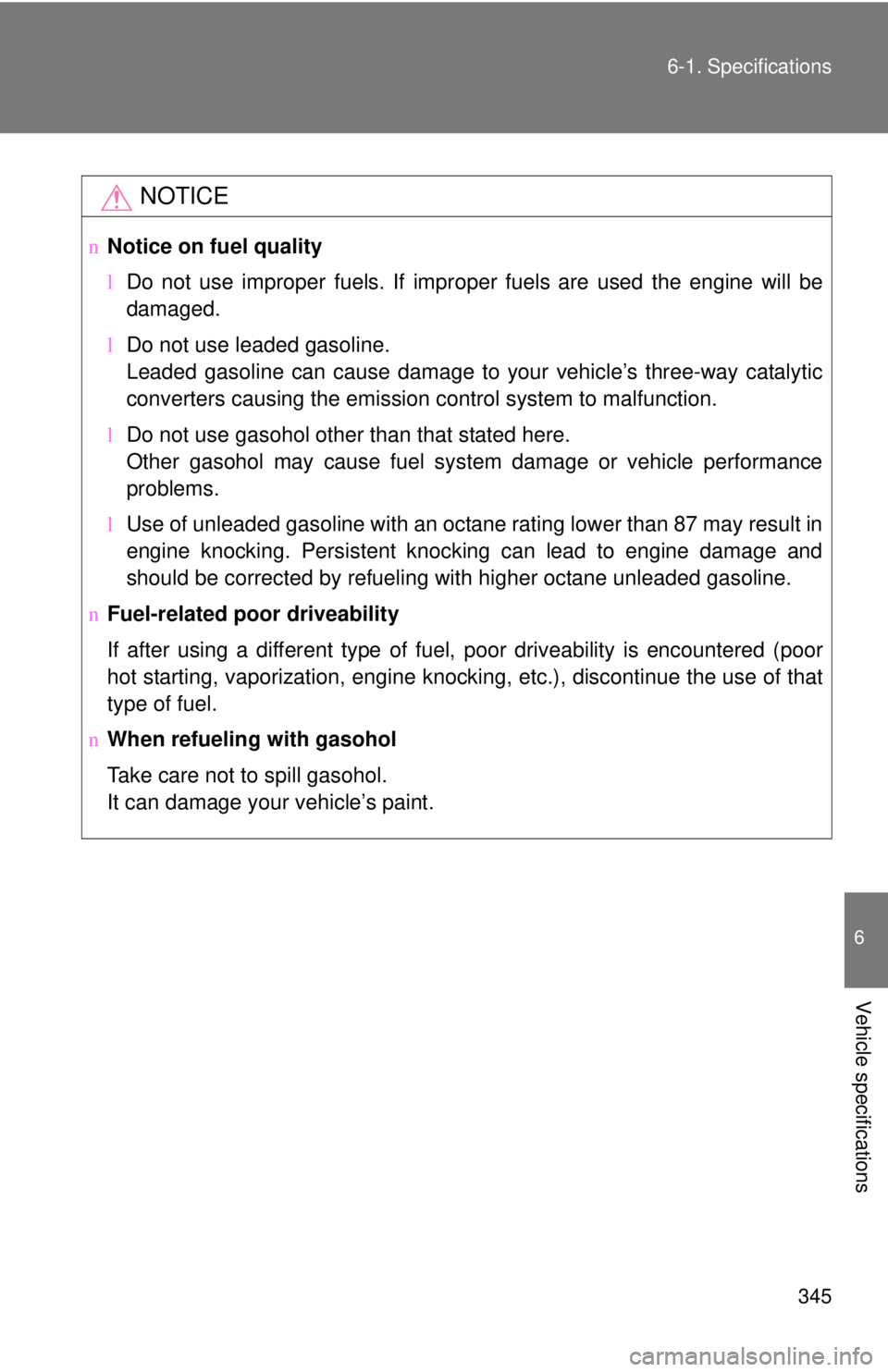
345
6-1. Specifications
6
Vehicle specifications
NOTICE
n
Notice on fuel quality
lDo not use improper fuels. If improper fuels are used the engine will be
damaged.
l Do not use leaded gasoline.
Leaded gasoline can cause damage to your vehicle’s three-way catalytic
converters causing the emission control system to malfunction.
l Do not use gasohol other than that stated here.
Other gasohol may cause fuel system damage or vehicle performance
problems.
l Use of unleaded gasoline with an octane rating lower than 87 may result in
engine knocking. Persistent knocking can lead to engine damage and
should be corrected by refueling with higher octane unleaded gasoline.
n Fuel-related poor driveability
If after using a different type of fuel, poor driveability is encountered (poor
hot starting, vaporization, engine knocking, etc.), discontinue the use of that
type of fuel.
n When refueling with gasohol
Take care not to spill gasohol.
It can damage your vehicle’s paint.
Page 377 of 386
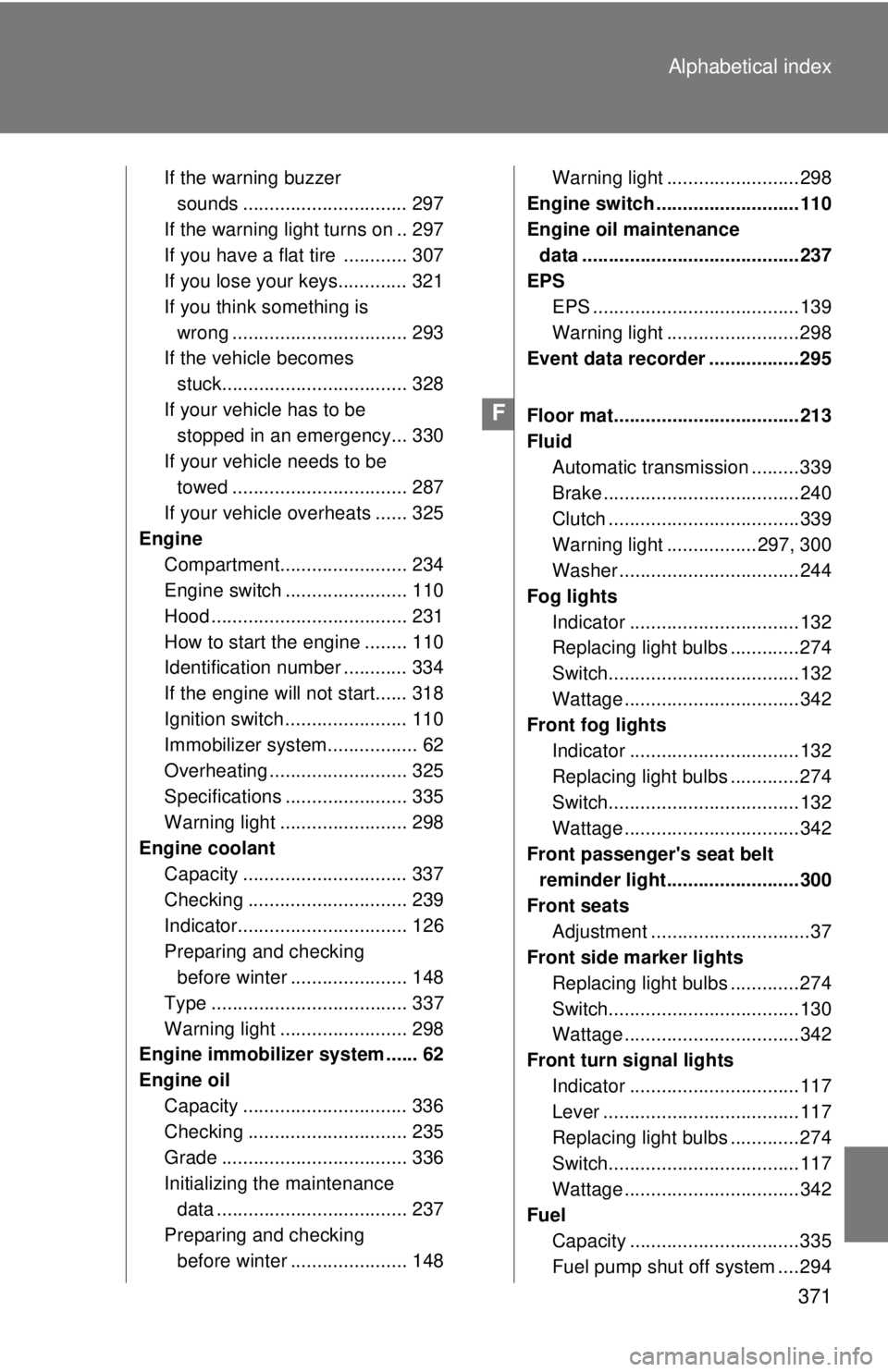
371
Alphabetical index
If the warning buzzer
sounds ............................... 297
If the warning light turns on .. 297
If you have a flat tire ............ 307
If you lose your keys............. 321
If you think something is wrong ................................. 293
If the vehicle becomes
stuck................................... 328
If your vehicle has to be stopped in an emergency... 330
If your vehicle needs to be towed ................................. 287
If your vehicle overheats ...... 325
Engine Compartment........................ 234
Engine switch ....................... 110
Hood ..................................... 231
How to start the engine ........ 110
Identification number ............ 334
If the engine will not start...... 318
Ignition switch ....................... 110
Immobilizer system................. 62
Overheating .......................... 325
Specifications ....................... 335
Warning light ........................ 298
Engine coolant Capacity ............................... 337
Checking .............................. 239
Indicator................................ 126
Preparing and checking before winter ...................... 148
Type ..................................... 337
Warning light ........................ 298
Engine immobilizer system ...... 62
Engine oil
Capacity ............................... 336
Checking .............................. 235
Grade ................................... 336
Initializing the maintenance data .................................... 237
Preparing and checking before winter ...................... 148 Warning light .........................298
Engine switch ...........................110
Engine oil maintenance
data .........................................237
EPS
EPS .......................................139
Warning light .........................298
Event data recorder .................295
Floor mat...................................213
Fluid
Automatic transmission .........339
Brake .....................................240
Clutch ....................................339
Warning light .................297, 300
Washer ..................................244
Fog lights Indicator ................................132
Replacing light bulbs .............274
Switch....................................132
Wattage .................................342
Front fog lights
Indicator ................................132
Replacing light bulbs .............274
Switch....................................132
Wattage .................................342
Front passenger's seat belt reminder light.........................300
Front seats Adjustment ..............................37
Front side marker lights
Replacing light bulbs .............274
Switch....................................130
Wattage .................................342
Front turn signal lights Indicator ................................117
Lever .....................................117
Replacing light bulbs .............274
Switch....................................117
Wattage .................................342
Fuel Capacity ................................335
Fuel pump shut off system ....294
F